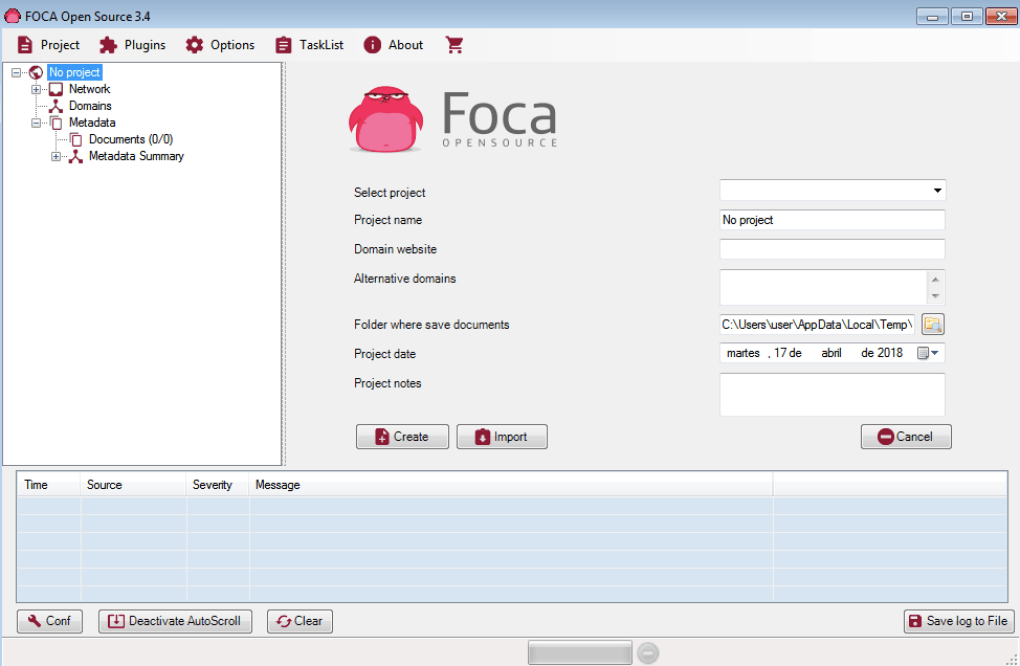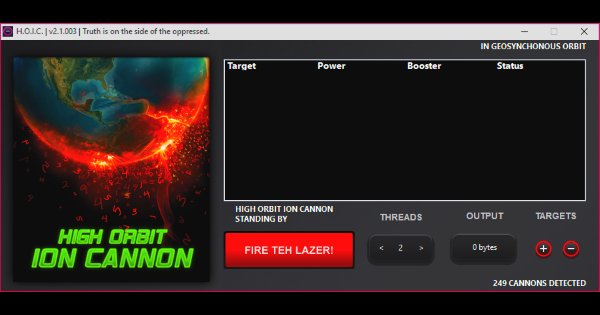Fakturama is a free inventory management software for your computer. It keeps a track. Inventory software full version.
A little tutorial on how to use LOIC which stands for Low Orbit ION Cannon, a hacking tool used to DOS websites.Download: http://sourceforge.net/projects/loi. How To Ping Flood Stress Test DOS Crash WebsiteServerNetwork LOIC Mac+Windows (Low Orbit Ion Cannon) - Duration: 7:07. Computers Tech wassup2190 Tips Tricks Tutorial 27,630 views.
Members of Anonymous are developing a new attack tool as an alternative to the LOIC (Low Orbit Ion Cannon) DDoS utility.
The move follows a spate of arrests thought to be connected to use of the LOIC, which by default does nothing to hide a user's identity.
The new tool, dubbed RefRef, due to be released in September, uses a different approach to knocking out websites. 64-bit download windows 7. LOIC floods a targeted site with TCP or UDP packets, a relatively unsophisticated yet effective approach, especially when thousands of users use the tool to join voluntary botnets.
RefRef, by contrast, is based on a more sophisticated application-level approach designed to tie up or crash the servers behind targeted websites instead of simply flooding them with junk traffic, according to a blog post on the development by an Anonymous-affiliated blog.
'Anonymous is developing a new DDoS tool,' the post explains. 'So far, what they have is something that is platform neutral, leveraging JavaScript and vulnerabilities within SQL to create a devastating impact on the targeted website.'
RefRef, which uses a 'target site's own processing power against itself' is undergoing field trials, with tests against Pastebin, the blog post by AnonOps Communications reports.
Arrests in UK, Spain and Turkey connected to LOIC-powered attacks have already prompted some core members of Anonymous to move towards using a new server and dropping LOIC in favour of other attack tools, such as Slow Loris and Keep-Dead DoS. This now seems to be purely a stop-gap measure while RefRef undergoes development.
LOIC was originally developed for network stress-testing, but later released into the public domain where, years later, it became a weapon of choice for hacktivists, most notably in the Operation Payback attacks against financial service organisations that blocked accounts controlled by Wikileaks last December following the controversial release of US diplomatic cables.
The problem with LOIC is that unless attacks are anonymised by routing them through networks, such as Tor, then users will be flinging junk packets that are stamped with their IP address at the targeted systems. These IP addresses can then be traced back to suspects by police.
Whether or not RefRef does a better job at anonymisation, by default, remains unclear but early experiments suggest that Anonymous is brewing a more potent attack tool. 'Supposedly, the tool will DoS a targeted website with ease,' Dancho Danchev, an independent cyber-threats analyst told El Reg. ®

| Original author(s) | Praetox Technologies |
|---|---|
| Stable release | |
| Written in | C# |
| Operating system | Windows, Linux, OS X, Android, iOS |
| Platform | .NET, Mono |
| Size | 131 KB |
| Available in | English |
| Type | Network testing |
| License | Public domain |
| Website | Official website |
Low Orbit Ion Cannon (LOIC) is an open-source network stress testing and denial-of-service attack application, written in C#. LOIC was initially developed by Praetox Technologies, but was later released into the public domain,[2] and now is hosted on several open source platforms.[3][4]
Use[edit]
LOIC performs a DoS attack (or when used by multiple individuals, a DDoS attack) on a target site by flooding the server with TCP, UDP, or HTTP packets with the intention of disrupting the service of a particular host. People have used LOIC to join voluntary botnets.[5]
The software inspired the creation of an independent JavaScript version called JS LOIC, as well as LOIC-derived web version called Low Orbit Web Cannon. These enable a DoS from a web browser.[6][7][8]
Countermeasures[edit]
Security experts quoted by the BBC indicated that well-written firewall rules can filter out most traffic from DDoS attacks by LOIC, thus preventing the attacks from being fully effective.[9] In at least one instance, filtering out all UDP and ICMP traffic blocked a LOIC attack.[10] Because internet service providers provide less bandwidth to each of their customers in order to provide guaranteed service levels for all of their customers at once, firewall rules of this sort are more likely to be effective when implemented at a point upstream of an application server's internet uplink. In other words, it is easy to cause an ISP to drop traffic destined for a customer by sending a greater amount of traffic than is allowed on that customer's link, and any filtration that occurs on the customer side after the traffic traverses that link will not stop the service provider from dropping excess traffic destined for that customer.[10]
LOIC attacks are easily identified in system logs, and the attack can be tracked down to the IP addresses used.[11]

Notable uses[edit]
Project Chanology and Operation Payback[edit]
LOIC was used by Anonymous (a group that spawned from the /b/ board of 4chan) during Project Chanology to attack websites from the Church of Scientology, once more to (successfully) attack the Recording Industry Association of America's website in October 2010,[12] and it was again used by Anonymous during their Operation Payback in December 2010 to attack the websites of companies and organizations that opposed WikiLeaks.[13][14]
Operation Megaupload[edit]
In retaliation for the shutdown of the file sharing service Megaupload and the arrest of four workers, members of Anonymous launched a DDoS attack upon the websites of Universal Music Group (the company responsible for the lawsuit against Megaupload), the United States Department of Justice, the United States Copyright Office, the Federal Bureau of Investigation, the MPAA, Warner Music Group and the RIAA, as well as the HADOPI, all on the afternoon of January 19, 2012, through LOIC.[15] In general, the attack hoped to retaliate against those who Anonymous members believed harmed their digital freedoms.[16]

High Orbit Ion Cannon
Origin of name[edit]
Low Orbit Ion Cannon Alternatives For Mac Pro
The LOIC application is named after the ion cannon, a fictional weapon from many sci-fi works, video games,[17] and in particular after its namesake from the Command & Conquer series.[18] The artwork used in the application was a concept art for Command & Conquer 3: Tiberium Wars.
Legality[edit]
While downloading and using the LOIC on one's own personal servers as a means of stress-testing is perfectly legal at least in the United States, using the program to perform a DDoS attack on other parties could be considered a felony under the Computer Fraud and Abuse Act of 1986. (CFAA) This charge could result in up to 20 years of imprisonment, a fine or both. [19]
See also[edit]
Low Orbit Ion Cannon Alternatives For Mac Os
References[edit]
Hoic Download
- ^SourceForge: [1]
- ^'Praetox Techlologies'. Archived from the original on 2010-10-08.
- ^'LOIC | Free Security & Utilities software downloads at'. Sourceforge.net. Retrieved 2014-11-17.
- ^'NewEraCracker/LOIC · GitHub'. Github.com. Retrieved 2013-11-22.
- ^'Pro-Wikileaks activists abandon Amazon cyber attack'. BBC News. 9 December 2010.
- ^Warren, Christina (December 9, 2010). 'How Operation Payback Executes Its Attacks'. Mashable.
- ^'Command & Conquer FAQ/Walkthrough for Nintendo 64 by DTran - GameFAQs'. www.gamefaqs.com. Retrieved 9 May 2017.
- ^Chapple, Mike; Chapple, University of Notre Dame Mike; Seidl, David (1 August 2014). Cyberwarfare. Jones & Bartlett Publishers. ISBN9781284058499. Retrieved 9 May 2017 – via Google Books.
- ^'Anonymous Wikileaks supporters explain web attacks'. BBC. 10 December 2010. Retrieved 11 December 2010.
- ^ ab'The attacks on GRC.COM'(PDF). GRC.com. 2001-02-06. Retrieved 2012-01-25.
- ^Nardi, Tom (March 3, 2012). 'Low Orbit Ion Cannon: Exposed'. The Powerbase. Archived from the original on March 6, 2012. Retrieved March 4, 2012.
- ^Hachman, Mark (October 29, 2010). ''Anonymous' DDoS Attack Takes Down RIAA Site'. PC Magazine.
- ^Moses, Asher (December 9, 2010). 'The Aussie who blitzed Visa, MasterCard and PayPal with the Low Orbit Ion Cannon'. The Age. Melbourne.
- ^'Anonymous Wikileaks supporters mull change in tactics'. BBC News. December 10, 2010.
- ^'Anonymous Hackers Hit DOJ, FBI, Universal Music, MPAA And RIAA After MegaUpload Takedown'. Forbes. Retrieved 2013-11-22.
- ^'THE INFORMATION DEFENSE INDUSTRY AND THE CULTURE OF NETWORKS - Amodern'. Amodern. Retrieved 2018-11-09.
- ^Homeworld, Homeworld 2, Unreal Tournament 2004, Ogame, Ratchet & Clank: Up Your Arsenal, StarCraft
- ^metatags generator (2012-09-27). 'Low Orbit Ion Cannon'. Archived from the original on September 27, 2012. Retrieved 2013-11-22.CS1 maint: unfit url (link)
- ^'18 U.S. Code § 1030 - Fraud and related activity in connection with computers'. LII / Legal Information Institute. Retrieved 2018-10-07.
External links[edit]
Low Orbit Ion Cannon Windows
| Wikimedia Commons has media related to Low Orbit Ion Cannon. |